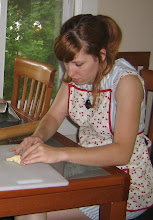Like my last pie, I decided to use the ingredients available to me in my kitchen and make a peach pie. This time, I was going to make the ENTIRE crust from scratch, using the same dough recipe and I would also roll out the dough with a rolling pin. I also took inspiration from Pie Therapy again, making a few changes, like using less sugar.
Peach Pie

Preheat oven to 425 degrees.
Dough Recipe (make more if necessary... I had some leftover from the last recipe):
Cut 1 stick of butter into 1.5 cups of flour. Add 1/2 t. salt if butter is unsalted. Slowly work in 3-5 T. of ice water until desired consistency is reached. Roll out dough on lightly floured surface and place in greased pie dish. Cut off extra dough to use for top crust. You may either make a woven top or a decorative one (pictured above).
Filling:
Blanche, peel, and slice (removing pits and red centers of) 10-12 small peaches (should yield about 5 cups). Pour on 1/8 t. almond extract and squeeze on half of a key lime.
Mix with:
1/2 cup sugar (the original recipe calls for 3/4 cup, which I think is excessive)
3 T. flour (I might've accidentally used 4... I got distracted and lost count)
1/2 t. cinnamon
1/8 t. salt
Pour into crust and top with dough styling of your choice. Bake for 40 minutes or until crust is brown on the edges.
What I would do differently:
-Try using ginger to give it an extra kick (however, the flavor of the peaches was already amazing).
-The original recipe says to "Dot with 2 T. butter", which I didn't really understand, but now I know it's to give the crust a more golden-brown/toasted look and texture.
I think the next pie will be a chocolate pie of some sorts. I also have a lot of winter squash in my house, so I might try that...
Dough Recipe (make more if necessary... I had some leftover from the last recipe):
Cut 1 stick of butter into 1.5 cups of flour. Add 1/2 t. salt if butter is unsalted. Slowly work in 3-5 T. of ice water until desired consistency is reached. Roll out dough on lightly floured surface and place in greased pie dish. Cut off extra dough to use for top crust. You may either make a woven top or a decorative one (pictured above).
Filling:
Blanche, peel, and slice (removing pits and red centers of) 10-12 small peaches (should yield about 5 cups). Pour on 1/8 t. almond extract and squeeze on half of a key lime.
Mix with:
1/2 cup sugar (the original recipe calls for 3/4 cup, which I think is excessive)
3 T. flour (I might've accidentally used 4... I got distracted and lost count)
1/2 t. cinnamon
1/8 t. salt
Pour into crust and top with dough styling of your choice. Bake for 40 minutes or until crust is brown on the edges.
What I would do differently:
-Try using ginger to give it an extra kick (however, the flavor of the peaches was already amazing).
-The original recipe says to "Dot with 2 T. butter", which I didn't really understand, but now I know it's to give the crust a more golden-brown/toasted look and texture.
I think the next pie will be a chocolate pie of some sorts. I also have a lot of winter squash in my house, so I might try that...


